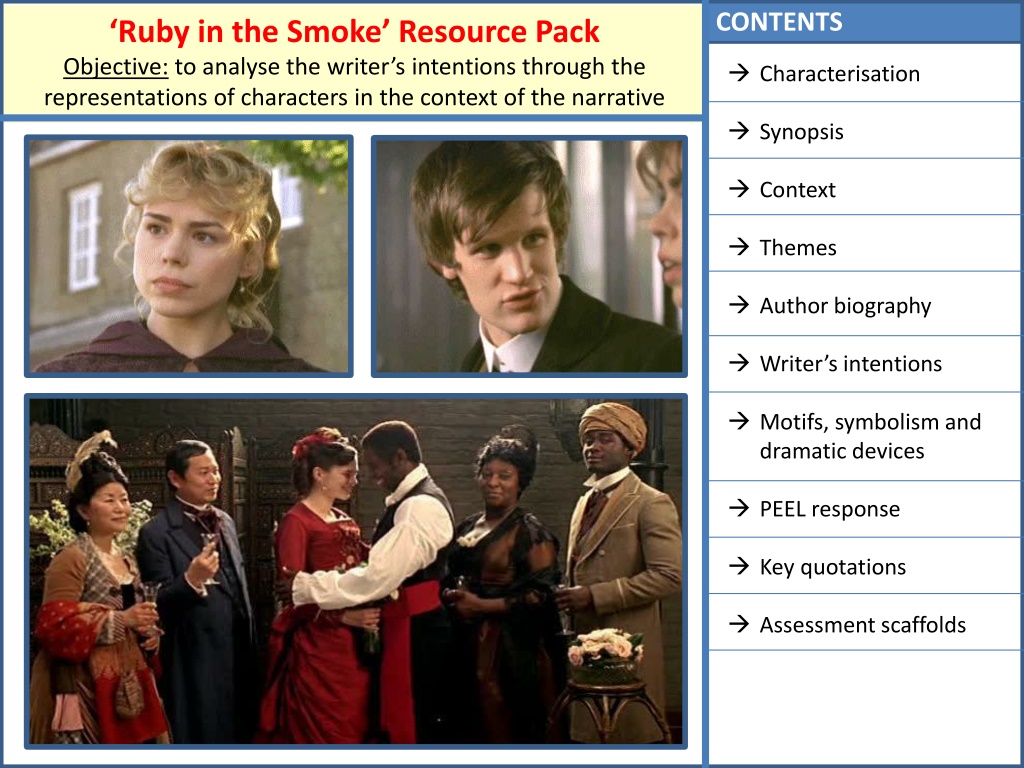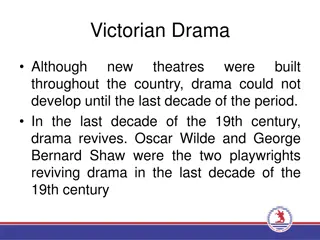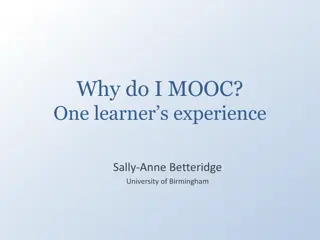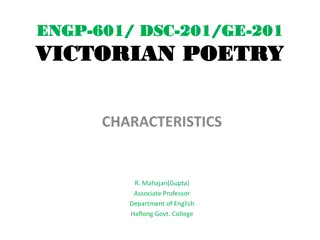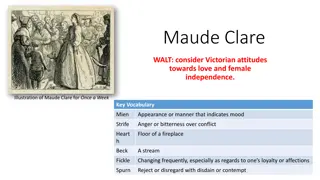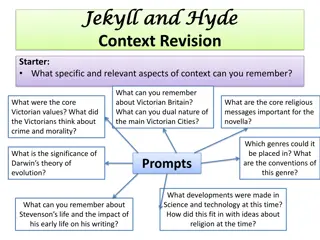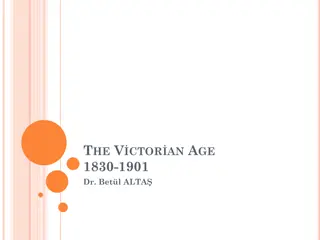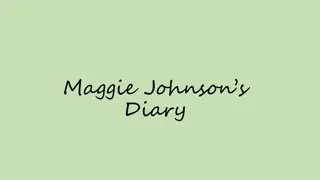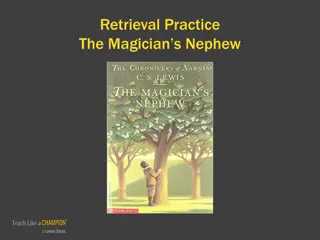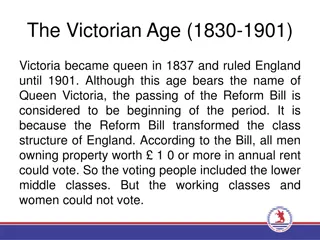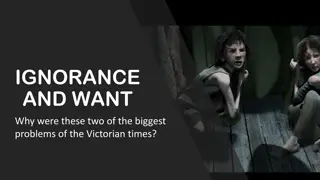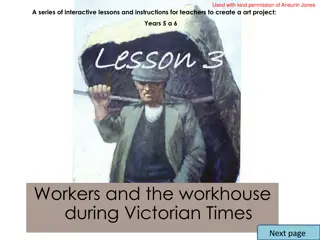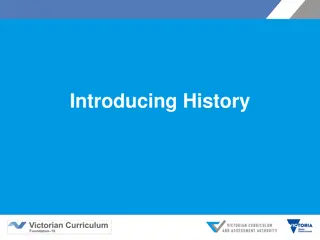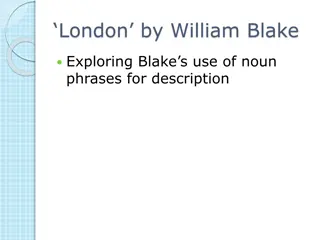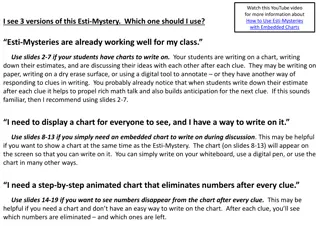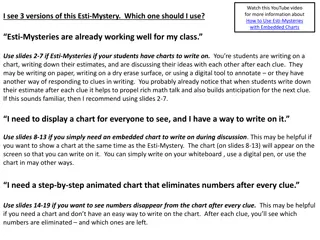Sally Lockhart Investigates Mysteries in Victorian London
Sally Lockhart, upon her father's mysterious death, delves into dangerous mysteries while avoiding the ominous "Seven Blessings." With the help of new friends, Sally uncovers secrets surrounding a valuable Ruby and her father's demise, eventually confronting dangerous adversaries and discovering hidden truths about her past.
Download Presentation

Please find below an Image/Link to download the presentation.
The content on the website is provided AS IS for your information and personal use only. It may not be sold, licensed, or shared on other websites without obtaining consent from the author. Download presentation by click this link. If you encounter any issues during the download, it is possible that the publisher has removed the file from their server.
E N D
Presentation Transcript
CONTENTS Ruby in the Smoke Resource Pack Objective: to analyse the writer s intentions through the representations of characters in the context of the narrative Characterisation Synopsis Context Themes Author biography Writer s intentions Motifs, symbolism and dramatic devices PEEL response Key quotations Assessment scaffolds
SYNOPSIS The Ruby in the Smoke' is a mystery story set in Victorian London. Sally Lockhart's father has just died and she has received a mysterious letter telling her to seek out Marchbanks and to avoid 'The Seven Blessings.' Sally begins to investigate and is soon drawn into two dangerous mysteries, one revolving around a much-desired Ruby, and the other concerning her father's death. By the end of the story, with the help of new friends, she manages to solve both mysteries. Sally goes to the offices of her late father's shipping firm, Selby and Lockhart. She has received a letter that warns her about the 'Seven Blessings.' She asks the company Secretary about this and he immediately dies of fright. A boy called Jim overhears this and decides to help Sally with her mystery. Sally returns to Mrs. Rees' house, a distant relative whom she has been living with since her father died. Sally receives a letter from Major Marchbanks, asking her to come see him in Swaleness. However, when she arrives he tells her that a dangerous woman called Mrs. Holland is in his house. He gives Sally an important parcel to read and then tells her to get away quickly. She does so, but is followed by Mrs. Holland. She sees a photographer on the pier and he agrees to let her hide in his tent until Mrs. Holland has gone. Sally opens Marchbanks' parcel on the train home. It is his diary. She reads an entry about him serving in India and seeing the beautiful Ruby of Agrapur. She then falls asleep and while she is sleeping, a man steals the diary, leaving only a page with a riddle on it. Meanwhile, a man called Matthew Bedwell arrives in London and stays at Mrs. Holland's lodgings. Mrs. Holland becomes interested in some information he has, so she keeps him drugged on opium to stop him from leaving. Bedwell tells Mrs. Hollands' servant Adelaide to contact Sally for him. Adelaide goes to Selby and Lockhart and talks to Jim, who passes the news on to Sally. Mrs. Holland hires a man called Mr. Hopkins to rob Sally of the paper with the riddle on it. He steals the paper but is mugged and killed in the street afterwards. Sally is horrified and realizes that she has to move. She leaves Mrs. Rees and goes to her lawyer, where she draws out all the money from her account. She then seeks out the photographer from the beach, Frederick. He and his sister Rosa invite her to stay with them in return for her help with the business. Frederick decides to help Sally with her mystery. They go to Oxford to find Bedwell's brother, who agrees to help them get Bedwell away from Mrs. Holland. Frederick takes Sally to an opium den to get some of the drug so they can wean Bedwell off it. Sally accidentally breathes in the smoke and sees a vision of her past. Mrs. Holland, with a hired thug called Mr. Berry, tracks down the thief who mugged Mr. Hopkins, and retrieves the paper with the riddle. As she is doing this, Frederick and Reverend Bedwell break in to her lodgings and manage to escape with Matthew Bedwell and Adelaide. Bedwell recovers and tells Sally the truth about her father's death. He was murdered by a criminal called Ah Ling, head of the Chinese Triad called The Seven Blessings. Sally decides it is time to get a gun to protect herself. Mrs. Holland finally manages to solve the riddle. She goes to the pub in Swaleness where the Ruby is hidden, but it is gone. Someone has already found it. Mrs. Holland is furious, and she retaliates by kidnapping Adelaide. Jim and Frederick immediately go after her. Jim manages to escape with Adelaide, but is caught again at King James's Stairs. There he and Frederick fight Mr. Berry, eventually defeating him. However, Mrs. Holland has left with Adelaide. Meanwhile, Sally decides to take opium again to see more visions of her past. She does so, and suddenly understands the importance of the Ruby. Rosa admits that Jim found the Ruby a while ago, but hid it to keep Sally safe. Rosa gives the Ruby to Sally. Sally arranges to meet Mrs. Holland at London Bridge, where Mrs. Holland explains that the Ruby was promised to her long before the Maharajah gave it to Lockhart. Lockhart then exchanged it for Marchbanks' baby. Sally is actually Marchbanks' daughter. Sally throws the Ruby into the river, but Mrs. Holland dives after it and drowns. Just when Sally thinks it is all over, a coach draws up and a man called Van Eeden kidnaps her. He tells her that he is Ah Ling, the man who murdered her father for interfering in his illegal opium trade. He threatens Sally with a knife, but she shoots him and runs away.Later, Sally receives a message to look in the clock tower at her old house. She finds ten thousand pounds that her father received for selling his share in Selby and Lockhart. She decides to put the money towards helping Frederick's business and finding the missing Adelaide.
Mrs Holland Adelaide Sally Lockhart Sally may only be 19 years old but she's a remarkable young woman - beautiful, with extraordinary strength and determination. She was orphaned when her father, shipping agent Matthew Lockhart, drowned when his ship went down in the South China Seas. Sally and her father were very close. Her upbringing was pretty eccentric: he taught her all about book-keeping, how to fire a pistol, and how to speak Hindustani like a native. Not exactly the ideal accomplishments of a Victorian lady. But Sally's remarkable assets will prove very useful indeed, as she is drawn into the dark web of secrets surrounding her father's death. Sally receives a note from a stranger which puts her in grave danger - particularly when she crosses the path of a terrifying old hag called Mrs Holland. But Sally also finds new friends in Jim Taylor, the company dogsbody at her father's firm, and the handsome photographer Frederick Garland. Together, they set about solving the mystery - and form close new friendships along the way... Mrs Holland is evil through and through. She runs a dingy lodging house in Hangman's Wharf in the darkest corner of Wapping, near the London docks. She rules this world with an iron fist, treating all who work for her with cruelty and contempt. Her young maid, Adelaide, lives in a constant state of terror. Even the burly thugs who do Mrs Holland's dirtiest work are too scared to cross her. But Mrs Holland was not always a malevolent old crone. In her youth, she was a great beauty and buried deep in this past-life is a secret which will lead Mrs Holland straight to Sally Lockhart. For she is totally obsessed with getting her hands on the famous Ruby of Agrapur. And, unknowingly, Sally is the only person who can stop her... Mrs Holland's small maid, only ten years old and covered in grime. But somewhere beneath the filth is a sweet young girl with flaxen hair and huge eyes - eyes haunted by a permanent and soul-destroying fear. Because Adelaide is scared to death of Mrs Holland's threats. If she makes a mistake, tries to run away, or even just stews the tea, then Mrs Holland swears she'll murder her and throw her body in the yard. It's no idle promise either - Adelaide has seen the bones of the last maid and she's desperate not to meet the same fate. But Adelaide can't help but be drawn into the mystery surrounding Sally Lockhart and the Ruby of Agrapur. And even though she finds some firm friends in the shape of Jim Taylor, Sally and Frederick Garland, it is all but inevitable that Mrs Holland will discover Adelaide is working against her... Frederick Garland Frederick is a photographer, boyishly handsome, in his late twenties with straw-coloured hair and good-natured features. He meets Sally Lockhart by chance when he helps her escape from Mrs Holland, who is in hot pursuit. Soon, he becomes Sally's closest friend - and takes her under his wing when she needs somewhere to stay in London. It's not long before an attraction grows between him and Sally, which could turn into something special.Frederick runs a small photography studio and shop in Holborn with his fiesty sister Rosa. But whilst Frederick has a fine creative brain, he isn't up to much when it comes to accounting so the business is not doing very well.When Sally moves in, she takes over the book-keeping and helps bring some order to the business side of things. In return, Frederick supports Sally in her quest to solve the mystery of her father's death, and overcome the evil Mrs Holland. Jim Taylor The company dogsbody at the Lockhart and Selby shipping firm. Jim is in his late teens, with a slightly unkempt and grimy appearance. He's lively, intelligent, and above all a true and loyal friend. In his spare time, Jim loves reading Penny Dreadful comics - their boys' own adventures and fiendish riddles appeal to his spirit of adventure. He's a great amateur detective too. Which makes him an absolutely indispensable help for Sally as she attempts to piece together the mystery surrounding the Ruby of Agrapur. Jim quickly becomes great friends with Frederick and Rosa, and takes little Adelaide under his wing. He'd do anything to save her - even if it means going against the evil Mrs Holland. Rosa Garland Frederick's sister, a fiesty and incredibly smart actress. She's unconventional, outspoken and knows her brother so well that they tend to finish each other's sentences off. When they're not arguing, that is.When Sally comes to live at Garland's, Rosa is a strong ally and friend to her and they grow almost as close as sisters. Rosa also finds herself growing very fond of the Reverend Nicholas Bedwell - who is drawn into her life because of his connection with Lockhart and Selby, and the death of Sally's father. Matthew Bedwell Matthew Bedwell worked for Sally's father, and was aboard the very ship which sank drowning him. Now, he's back in London with one mission. To tell Sally the truth about what happened.But unfortunately Matthew is an opium addict, a dark obsessive habit which threatens to overcome him. He falls into the wrong hands, ending up in Mrs Holland's lodging house. Matthew manages to get word to Sally through Mrs Holland's maid, Adelaide. It will take all their best efforts - and those of Matthew's twin brother, Nicholas - to get him out of harm's way... Nicholas Bedwell Nicholas Bedwell is the curate of St John's, Summertown Oxford. He's also got a remarkably fine right hook, having boxed for his university. It's a skill which comes in very useful when Nicholas has to fight Mrs Holland and her thugs in order to rescue his poor twin brother, Matthew.Nicholas is loyal, strong, wise and kind - a great friend to Sally Lockhart, and a real thorn in Mrs Holland's side.
SETTING LITERARY QUALITIES While the novel is set in England in 1872, there are occasional scenes from the Orient provided by Sally's opium-induced dreams as well as by the recollections of other characters. That Pullman has well-researched this era is reflected in his accurate descriptions and his allusions to actual events and locations. The reader is treated to an overview of 1870s England with its crime and poverty, and to a picture of a sick society with its opium dens. Although unfamiliar items such as box lock pistols, mudlarks, and hansom cabs are mentioned in the novel, Pullman explains what they are as he refers to them. Pullman's novel is written in the style of a melodrama with the stock characters of the noble hero, the cold-blooded villain, and the virtuous heroine. While Sally Lockhart fills the role of the heroine, Jim and Frederick assume the roles of the heroes with some assistance from the Reverend Bedwell. Mrs. Holland and Hendrick Van Eeden are cast as the primary villains. Throughout the book are the typical melodramatic elements of emotional scenes, impossible situations, and dramatic chases. Also woven into the story is a look at the social evils of the time. Cliff-hangers at the ends of chapters are reminiscent of the works of serial writers of the 1800s such as Charles Dickens. Pullman's vivid descriptions of the setting create an atmosphere of mystery and add to the feeling of suspense throughout the novel. For example, when he describes the town of Swaliness where Sally visits Mr. Marchbanks, Pullman hints at the gloom and impending danger when he writes: "The town was cheerless and cold, and the river a muddy creek that wound its way among salt flats before entering that distant line of gray that was the sea. The tide was out; the scene was desolate." The novel consists of two parallel plots that are closely intertwined. It is only when both are joined in the exciting conclusion that the events of the novel and the actions of the characters finally fall into place. One plot is the story of Sally's quest to unravel the mystery of Captain Lockhart's death. This leads her to the shipping firm of Lockhart and Selby, to Mr. Marchbanks, then to Matthew Bedwell and Mrs. Holland, and eventually to the sinister pirate Ah Ling. The second plot is the story of Mrs. Holland's search for the Ruby of Agrapur. Tying these two plots together are the characters of Mr. Marchbanks who is Sally's real father, and Matthew Bedwell who is a sailor with information about Mr. Lockhart's death. This pattern is reflected in the overlapping motifs of the... KEY THEMES SOCIAL SENSITIVITY Although there is violence in the novel, most of the truly bloody events are only alluded to, and most of the violence happens to the villains. For example, when Matthew Bedwell describes the sinking of the Lavinia, he remembers that "the sharks came. The poor devils didn't have a chance," and when Mr. Selby takes a trip to see a boat, the reader is not sure that he has been murdered until his body is found floating in the river. Opium and Trade THE NOVEL S TOPICS FOR DISCUSSION Friendship and Loyalty 1. Folklore often gives symbolic meanings to gem stones. For example, a red stone worn by a man is said to indicate nobility and leadership and also to signify vengeance. On a woman, a red stone is said to indicate pride, obstinacy, and haughtiness. Identify the people in the book who possessed the Ruby of Agrapur. Did they possess any of these characteristics? Strong Women and Victorian Attitudes 2. Throughout the novel, Pullman provides excellent descriptions of the London of 1872. Using passages from several parts of the book, describe the area around the East India Docks and Wapping where Mrs. Holland lives. KEY SYMBOLS/CONTEXT The British opium trade in the 1800s is frankly discussed and the opium dens and opium smoking are described. However, the descriptions are accurate and reflect the history of the British opium trade at that time. The book does not glamorize the trade or the effects of opium on those who use it. In fact, Pullman's description of Matthew Bedwell when he first arrived in London's West India Docks presents a picture of a man who is barely alive. "But if anyone had seen into his mind and sensed the chaos that reigned in the dark place, they would have thought it remarkable that he managed to keep going at all." 3. Although Sally seems independent, she sometimes uses her female charms to help her in situations. Locate and describe examples of her independence and of her use of female charms. What do they tell us about her intelligence and personality? The Ruby of Agrapur Victorian London Sally s Gun Selby and Lockhart Shipping Agents Swaleness The Turk s Head Penny Dreadful Opium Den East India Company Burton Street Omnibus Mudlarks Stereographic Pictures 4. After meeting Mrs. Holland on the bridge and learning about her past, Sally throws the gemstone off London Bridge. Why does she do that? Knowing that the ruby was valuable, why did she not keep it? 5. Throughout the book are terms for items which were common during Sally Lockhart's time such as box lock pistols, mudlarks, hansom cabs, and penny dreadfuls. First use the novel to identify and define these and other Victorian terms. Then, for terms which are still unclear, find their meaning in a dictionary or encyclopedia. 6. Define foreshadowing and find examples of its use throughout the...
QUESTIONS FOR EXTENDED STUDY FROM QUOTE FINDING TO PEEL ANALYSIS 1. While Sally's Ruby of Agrapur is fictitious, there are many famous gemstones, some of which have legends or dramatic tales surrounding them. Examples of famous gems include the Hope diamond, the Koh-i-noor diamond, the Cullinan diamond, the Rosser Reeves star ruby, the Star of India sapphire, and the DeLong star ruby. Research one or several of these or other well-known gemstones and chronicle their histories. Focus passage: Bedwell s description of the Pirate Junk (p131-132) Task: locating similes, personification, symbolism and metaphor Simile Personification Symbolism Metaphor 2. The Ruby belongs to the family of gems called corundum. Explore the corundum gems. What is included in the family? Where are they found? What are the properties of the gems? like a puppet in one of the shadow- plays with an air of watching us made my blood run cold and the sea, it was alive with phosphorescence 3. Sally Lockhart was an independent woman, just like Queen Victoria who ruled the British Empire during the time of Sally's adventures. Describe the life of Queen Victoria and discuss her importance in history. solid blackness like a paper cut- out now those seas are might bust the junk was the only thing in the glowing panorama that was dark our wake and our bow-wave were great, swirling tracks made up of billions of spots of white lights. 4. Write an overview of the Opium Wars of 1839-1842 and 1856-1860. Discuss why they were fought and who participated in the wars. Then examine the results of these wars and explain their importance not only to the opium trade but to trade and commerce in general and to the power of the British Empire. 5. During Sally Lockhart's time, the British Empire extended over vast parts of the world. Identify the areas of Eastern Asia and the Indian subcontinent that were controlled by England. Then pick one area to explore in detail. How did British rule change that area? tack like a schooner just crawling, creeping, dawdling across the water 6. The adventures of Sally Lockhart take place in 1872... and the sea, it was alive with phosphorescence ADAPTATIONS OF RUBY IN THE SMOKE BOOK CHAPTERS Chapter 1 - Blessings Chapter 2 The Web Chapter 3 The Gentlemen of Kent Chapter 4 - Mutiny Chapter 5 The Ceremony of the Smoke Chapter 6 - Messages Chapter 7 The Consequences of Finance Chapter 8 The Passions of Art Chapter 9 The Journey To Oxford Chapter 10 Madame Chang Chapter 11 The Stereographic Repertory Co. Chapter 12 - Substitution Chapter 13 Lights Below The Water Chapter 14 Arms and the Girl Chapter 15 - The Turk s Head Chapter 16 Protecting The Property Chapter 17 King James s Stairs Chapter 18 - London Bridge Chapter 19 - East India Docks Chapter 20 The Clock Tower Easy I think [quote] is interesting / effective / entertaining because... These words / This phrase helps readers ... The Ruby in the Smoke is the first of Pullman's trilogy about Sally Lockhart. In Shadow in the North, Sally has established her own business as a financial adviser. When one of her clients confronts Sally with the collapse of a shipping firm that Sally recommended, Jim and Frederick try to solve the mystery of what happened to the firm. In the final book, The Tiger in the Well, Sally is threatened with a divorce from a man whom she has never met. When her "husband" tries to take all of Sally's savings and her young daughter, Sally sets out to find the person behind the evil plot to ruin her life. Difficult The writer uses simile/metaphor/personification/symbolism when he says [quote] in order to show PEEL QUESTION: How has Pullman used language devices in Chapter 13 in order to convey something important about character, context, mood and/or atmosphere in the scene? Point Pullman uses [insert language device] in order to show Evidence For example, he adds Explain The effect of this quotation on the reader is Link Pullman s intention is to
LANGUAGE AND MEANING SETTING NARRATIVE POINT OF VIEW The story is set in Victorian London. At this time, women were expected to remain demure, ladylike, submissive and in the home. A woman's role was to be a good wife and mother. Sally defies these conventions of society, as she is a very strong, independent and capable girl. She does not need a man to accompany her or to take care of her. This sometimes gains her disapproval, but she soon finds a place where she can belong. Fredrick and Rosa are quite unconventional too, and they do not mind Sally's uniqueness at all. In fact, they like and admire her all the more because of her strength, confidence and business skills. Other elements of the Victorian world also come into the story. There are no cars since people travel by train or coach and photography is still a new and exciting invention. Trade with the East Indies and China is extremely important, and opium is central to the plot. Sally's father was once an officer serving in India, which at this time was ruled by Britain. Jim likes to read 'Penny Dreadful' magazines, which were periodicals with serialized short stories about heroes, mysteries and monsters, known for their lurid details. The author does a good job of conjuring up the atmosphere and details of Victorian London. The author also shows the 'hidden' side of the Victorian world. This is the side of Victorian Britain that is sometimes forgotten. The Victorian times were ones of great invention, exploration, discovery, wealth and opportunity, but they also had their darker side. In this story the reader is told about the government's corrupt dealings in opium, and how they went to war with China in order to force them to accept the drug. They did not care how many people suffered as long as they could continue to profit from it. This is explored in this story through the prominence of opium. Sally sees how opium ruins ordinary people's lives, then comes to see how opium is at the root of all her problems. The Ruby of Agrapur was bought with money from opium, and the Mutiny in which the Maharajah died and the ruby was exchanged for Sally, was caused by the opium trade. Sally sees opium dens in the city, and comes to understand that opium is a terrible evil. However, as Frederick points out, there are perhaps even worse evils. Sally sees poverty on a scale she had never imagined. There was a huge gap between rich and poor in Victorian cities, and this is portrayed in this story. There are beggars on the streets and children forced to scour the river mud for valuable items just to survive. Jim is betrayed by a boy he thought was his friend, because he was so desperate for money. These represent the 'hidden' side of Victorian Britain and the consequences of the great wealth and expansion of the empire. The language used for the narration of the story is fairly simple, allowing the narrative to flow gently and to be easy to understand. Characters speak differently, as they come from a Victorian world. The way a character talks, and the language he or she uses, indicates their place in society. In Victorian times, there were much greater gaps between different social classes, reflected in their speech and accents. For example, Sally speaks very properly, without using colloquialisms, in a similar manner to Frederick and Rosa. This reflects the fact that they were all born into wealthy, respectable families. Sally seems to be rich middle class, and Frederick and Rosa probably have a similar background. In contrast to this is Jim, who speaks with a cockney accent that is indicated phonetically in the writing. For example, the writer drops h's in Jim's speech to show that Jim is also dropping his h's. Jim uses a lot of colloquialisms, slang and abbreviations. He has never been taught to speak with received pronunciation as the richer members of society are, and he has obviously picked up a lot from the streets. Trembler and Adelaide also speak in a similar manner, although their accents do not seem to be as extreme as Jim's. Other characters speak in a manner that indicates their intellect or level of education. Jim's accent might be working class, but he is sharp and quick and his speech indicates this. Mr. Berry and Mr. Hopkins, however, barely speak at all, and when they do their speech seems slower and less thought out. This indicates that they are men of muscle rather than brains; they are Mrs. Holland's hired thugs who are there to beat people up but not to contribute much else. All of this helps to conjure a sense of atmosphere and makes Pullman's world more realistic. The story is told in third person by the author who has quite a conversational voice that makes the reader feel close to the narrator. He will sometimes point out something or explain something as if he is talking directly to the reader, which helps the reader to feel more involved in the story. At first the story is told from Sally Lockhart's point of view. She is the main character, so the reader is introduced to the world and the mystery through her eyes. She is a strong, independent and confident girl who is intrigued by the mystery and determined to solve it. However, she can also be unsure, self-conscious and vulnerable. She does not really know how to talk to people, and when she interacts with others this sometimes comes out as shyness. Sally does not like to show the rest of the world this vulnerability, trying to hide it by being businesslike, such as when she offers to pay Frederick for the use of his tent. When she is feeling awkward or confused, it is not always easy for others to tell. Providing the reader with a deeper insight into what she is thinking and feeling, therefore, allows them to understand and sympathize with her better. As the story continues, many other point of view characters are introduced. The reader sees things from the perspective of Mrs. Holland, Marchbanks, Bedwell, Mr. Hopkins, Jim, Adelaide, Selby, and occasionally even Van Eeden. There is also one section from Ellen the maid's point of view. However, the majority of the story is still seen through Sally's eyes. The reader therefore sometimes sees things that Sally and her friends do not. Out of all the characters, the readers have more clues than anyone else, and so they can solve the mystery sooner. This makes the story more interactive and fun. This also means that suspense and tension can be increased, as the reader will often know when a character is in danger when they themselves do not. Occasionally the author will describe a scene without showing any character's particular point of view. For example, this happens when Frederick and Reverend Bedwell go to Mrs. Holland's lodgings to rescue Matthew Bedwell. The reverend is not a point of view character, so the reader gets no insight into what he is thinking. Frederick's own thoughts and feelings are deliberately kept mysterious from the reader, as we are left in suspense as to how he really feels for Sally. This is why Frederick cannot be a point of view character. STRUCTURE The book is split into fairly short chapters that move the story along very quickly. The story is fast-paced and exciting, with plenty of action amid the talking. Scenes shift very quickly between different characters, adding to the fast, slightly frenzied feel. The reader gets the impression that events are moving very quickly and that Sally will have to keep up or risk getting into even deeper danger. The mystery itself is introduced in the first chapter, but is only revealed in tiny little bits of information constantly throughout the novel. This helps to keep the reader's interest and anticipation up. Some events and people are introduced with very little explanation, which seems confusing at first. The end of the book ties all these strands together, however, bringing light to various things that are said or done. This makes it an interesting experience to re-read the story even though the reader now knows exactly what is going to happen.
Important quotations throughout the novel which could be used for your final assessment: SALLY S CHARACTER TRAITS- "She was learning that if she pretended to be weak and frightened, and dabbed at her eyes with a lacy handkerchief, she could turn aside all manner of pressing questions"(Chapter 2, The Web. p. 14). THEME OF GENDER ROLES - "She felt somehow that the pretence of helplessness, which worked so well with other men, would not take him in for a moment. That was why she had offered to pay him: she wanted to meet him on equal terms" (Chapter 3, The Gentleman of Kent. p. 32). THEME OF CLASS - "Her upbringing had given her an independence of mind that made her more like a girl of today than one of her own time - which was why she had walked out, and why she was not daunted by the prospect of being alone" (Chapter 8, The Passions of Art. p. 63). THEME OF CLASS AND STATUS - "They don't think of Trembler as a servant. And they don't think of me as a girl. We're all equal. That's what's so odd" (Chapter 8, The Passions of Art. p. 75). FREDERICK S CHARACTER TRAITS - "...talking to Frederick, and listening to him, seemed the most natural and agreeable thing in the world - but she found herself, once seated facing him across a table set with cutlery and napkins and glasses, absurdly tongue- tied" (Chapter 9, A Journey to Oxford. p. 78). THEME OF RITES-OF-PASSAGE FROM CHILDHOOD TO ADULTHOOD - "Their shouts and laughter made her feel cold and deprived; where had her childhood gone? And yet only an hour or two earlier she had felt on fire with embarrassment because she was a child, and had none of the ease of an adult" (Chapter 9, A Journey to Oxford. p. 82). CONTEXT/MOOD/ATMOSPHERE - "these quiet houses and leafy gardens seemed to be on a different planet from the darkness and mystery and sudden death she was returning to" (Chapter 9, p. 82). CONTEXT - "She would have given anything to be able to forget London and Mrs. Holland and the Seven Blessings, and to live in one of these large, comfortable houses, with children and animals and bonfires and lessons and games...Perhaps even now it wasn't too late to become a governess, or a nurse or...But it was. Her father had died, and something was wrong, and there was no one but her to set it right" (Chapter 9, p. 82). THEME OF MYSTERY - "there was a legend that the evil of the stone would persist until it was laid to rest by a woman who was its equal" (Chapter 9, p. 83). SALLY S CHARACTER TRAITS - "I know so little! I don't even know how to talk to people. And what I do know is so...I don't know how to put it. It's just not the sort of things that girls know" (Chapter 11, The Stereographic Repertory Company. p. 97). SALLY S CHARACTER TRAITS - "Sally wanted to help; she was full of impulses of kindness, but did not know how to express them" (Chapter 12, p. 117). NARRATIVE DEVELOPMENT - "She knew she could learn more - but at the cost of another journey into the Nightmare. And she couldn't pay that; not yet. It was so ironic. Because for the first time she had friends, and a home, and a purpose" (Chapter 16, p. 157). FREDERICK S CHARACTER TRAITS - "It was easier to think about Frederick. Such a mixture of lazy flippancy and passionate anger, of Bohemian carelessness and dedicated perfectionism! Frederick was a topic to fascinate any psychologist" (Chapter 16, p. 157). SALLY S CHARACTER TRAITS - "Her heart was beating fast. What she felt for Frederick was so confused and powerful that she couldn't begin to articulate it" (Chapter 17, p. 163).
Additional Help Sheet Language devices Metaphor Sentence starters Emotive language Pullman uses first person narration to show how Sally is Simile Personification Symbolism First person narration Dialogue Contextual detail Variety of sentence structures Rhetorical questions Statistics Powerful verbs and adjectives Pullman employs emotive language in the following scene in order to show The repeated use of descriptive contextual detail about the Victorian era illustrates that Helpful connectives and sentence starters you could use: Firstly Similarly On the other hand The effect of this choice is In conclusion One might argue that Consequently As a result In contrast The writer s purpose is However This shows that This illustrates that This gives the impression that This highlights that Therefore Helpful mid-sentence connectives to shows illustrates depicts emphasises connotes points out links represents proves defines contrasts conveys expresses gives the impression portrays differs
Assessment Focus Areas In Detail AF2: Understanding and using quotations Developing I can identify most relevant points clearly, including those from different places in the text and my comments are generally supported by relevant evidence. Secure I identify relevant points clearly, including summary and synthesis of information incorporating apt textual reference and evidence. Exceeding Precise selection and use of quotations and using wider knowledge to develop your argument. AF3: Inferring Developing I can develop explanation of inferred meanings based on textual evidence. Secure My comments are securely based in textual evidence and identify layers of meaning, with some attempts at detailed explanation. Exceeding Develop an interpretation by considering the relative importance of different pieces of evidence, even exploring what is left unsaid. AF5: Language Developing I can identify a range of language techniques and add some explanation of their effect on the reader. Secure Detailed analysis, with correct terminology, of how language is used and some analysis of its overall effect on the reader. Exceeding Develop a precise and perceptive analysis of how language is used and appreciate how language choices contribute towards the overall effect on the reader. AF7: Context Developing I can explain how the text relates to its context. Secure Some detailed discussion of how the context of the text is linked to its meaning. Exceeding A thoughtful analysis of how the context of the text links to how it was written and/or how it is interpreted by the reader.
